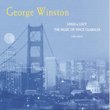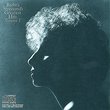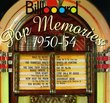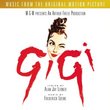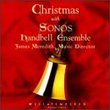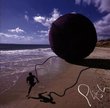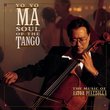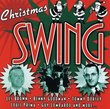| All Artists: Pyotr Il'yich Tchaikovsky, Antal Dorati, Royal Concertgebouw Orchestra Title: The Sleeping Beauty Members Wishing: 0 Total Copies: 0 Label: Philips Release Date: 6/13/1995 Genre: Classical Styles: Ballets & Dances, Ballets, Historical Periods, Modern, 20th, & 21st Century Number of Discs: 2 SwapaCD Credits: 2 UPC: 028944616620 |
Search - Pyotr Il'yich Tchaikovsky, Antal Dorati, Royal Concertgebouw Orchestra :: The Sleeping Beauty
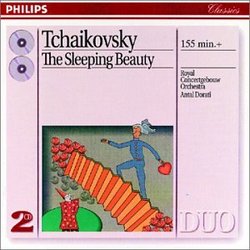 | Pyotr Il'yich Tchaikovsky, Antal Dorati, Royal Concertgebouw Orchestra The Sleeping Beauty Genre: Classical
No Description Available No Track Information Available Media Type: CD Artist: TCHAIKOVSKY,P.I. Title: SLEEPING BEAUTY-COMP Street Release Date: 06/13/1995 |
Larger Image |
CD DetailsSynopsis
Product Description No Description Available No Track Information Available Media Type: CD Artist: TCHAIKOVSKY,P.I. Title: SLEEPING BEAUTY-COMP Street Release Date: 06/13/1995 Similarly Requested CDs
|
CD ReviewsThe Sleeping Beauty in all its splendour Marc Haegeman | 02/17/2003 (5 out of 5 stars) "To describe this recording as just 'lovely' is about as great an understatement as the Tsar merely observed: 'Very charming' after the premiere of "The Sleeping Beauty" in 1890. It's also a serious misunderstanding of the purpose of the recording of a ballet score, which is never intended to accompany a performance. What Antal Dorati proves beyond all is exactly that this music can stand on its own, without the support of the dancers on the stage.Antal Dorati and the Concertgebouw Orchestra present here simply one of the very best recordings of "The Sleeping Beauty". With its unique rendition of the orchestral colour, the dramatic flow, the theatrical eloquence, and the ever correct characterisations, this release stands out, leaving most of the competition behind.The Concertgebouw Orchestra of Amsterdam is definitely one of the world's finest ensembles and quite ideal for this kind of repertoire, moreover, magnificently recorded in the warm acoustics of the Concertgebouw itself during the final years of the analogue era. The clarity of instrumental detail, the transparency of the sound image (just listen to the buildup in the famous 'Rose adagio' from Act 1), are nothing short of ideal, while the superbly played solos (Jean Decroos and Theo Olof) are convincingly blended within the ensemble.This recording was originally released on a three-disc set and it is a pity that Philips has decided to cut the entire Entr'acte (nr. 18 of the score) in order to make it fit on two discs. Nonetheless, Dorati's version remains a clear first choice for anyone wishing to explore one of the greatest orchestral works of the 19th century." Tchaikovsky's Masterpiece On A Great Recording Rudy Avila | Lennox, Ca United States | 07/27/2005 (5 out of 5 stars) "While there are many fine renditions of Tchaikovsky's Sleeping Beauty on disc, this has got to be my choice for trophy winner. Antal Dorat was no stranger to ballet conducting (he conducted all three Tchaikovsky ballets - Swan Lake and Nutcracker included as well as Adolphe Adam's Giselle). Dorati's legacy lives on through many remastered LP recordings on CD- he conducted Tchaikovsky repertoire with the most passionate musicianship. Sleeping Beauty was Tchaikovsky's ballet masterpiece, a work full of noble music, enchanted melodies, timelessness, a score tinged with yearning for lost magic, for chivalry, for romance. It's a mystery sometimes the nature of this music. For one thing, it's not entirely balletic. While choreographers can work with Tchaikovsky's music, there is something transcendent about the music that doesn't seem entirely balletic. There's a concerto quality to it, as well as a symphonic quality, operatic (opera) quality to it. Dorati was masterful at capturing all these different aspects. Eventhough this recording was made in the early 80's and Dorati was approaching his death, its crisp, beautiful and dynamic. Do yourself a favor, listen to the following and you'll understand why Sleeping Beauty is the best ballet ever made: 1)The Christening: Prologue, March, Carabosses's Entrance. The mood here is one of courtly romance. Many of the dances seem stately and fairy-like (after all many of the guests at the Christening are fairies and angelic beings). The original production was modeled after the court of Louis XIV, and Tchaikovsky loved old French pageantry. It appealed to his sense of aesthetics- flowing, eleaborate Roccoco as he used in Mozartiana and Roccoco Variations. He used an aria from Richard Cour De Leon in Eugene Onegin the opera. Honoring the ancient "Ballet" of Louis XIV, where ballet really began, the music for the first part of Sleeping Beauty is full of this classical throwback. When Carabosse enters, the mood changes to one that is diabolical in a very "quiet", subtle way, it's haunting and a tad intense, but I figure the music for this evil entity is not too powerful to emphasize her femininity. Carabosse (or in the Disney film Maleficent) is the evil fairy who was not invited to Aurora's Christening. As despairing and dark as the mood is, light and hope returns when in a brilliant coda the Lilac Fairy's Theme is heard. 2:Rose Adagio, Waltz and Death Scene: This is Tchaikovsky at his best as a composer. The music is both jovial, triumphant, ecstatic, orgasmic, thunderous but melancholy and tragic. Somehow, somehow, he was able to write music that not only describes the well-known fate of Sleeping Beauty- she pricks her finger and dies- but expressed something deeper, something more philosophical. Tchaikovsky was a gay man or perhaps (and this is just my theory) he was a man who longed to be a woman. Because he could never be himself in the austere Catholic Imperial Russia, he became himself or became female in his music. And even then he wrote music which was extremely heartbreaking and tragic, and his despair and crisis is clearly evident. In the Rose Adagio, Aurora becomes a woman (she starts menstruating) and is courted by different princes who each offer her a rose. In a series of demanding turns, she accepts their roses. The music for this seemingly trivial scene is incredibly powerful and spiritually, the music escalates to heavenly heights. The Waltz is well known for its lilting familiar melody that Disney put words to - "I know you I waltzed with you once upon a dream". The Death Scene is so well-composed that one even sees Aurora dizzy, bleeding, sick and dying in a few minutes of music. Then we hear the evil laugh of Carabosse when she reveals herself and once again we despair. But then comes hope in the form of, that's right, the Lilac Fairy Theme. "Not in death but in sleep" she could well be saying as in the Disney film, "she will awake with true love's kiss. For true love conquers all." 3: Skip to the final track. That Apotheosis! It's climatic, it's melancholy, it's spiritual. It belittles the audience and seems to be about something other than a happy ending for Aurora and her Prince. This is a moment of climax, or rather anticlimax since to many people the Rose Adagio is more powerful. But the Apotheosis is equally as transcendent. One cannot help but feel something. Enjoy this recording, it was meant to be appreciated by ballet fans and Dorati fans and fans of great music." The Perfect Ballet Score Rachel Garret | Beverly Hills | 01/05/2003 (5 out of 5 stars) "For those fans of the incredible living art of ballet, this cd is a remarkable treat. Although nothing beats a live performance, or one captured on film, the score to a ballet is just as enjoyable and as uplifting to hear. Antal Dorati (conductor of the Monte Carlo Ballet, symphonic conductor post World War II- 50's, 60's) began his career in the 30's. A perfectionist, a master, he is everything the great Maestro Toscanini was to the conducting podium. Dorati has conducted Sleeping Beauty many times, in Monte Carlo and in Detroit. The Royal Concertgebouw Orchestra is a European orchestra that Dorati worked with toward the end of his life. In this recording, the European elegance of the ballet is marvelously captured- the perfect detail on the strings, the sheer symphonic treatment and coloration of each individual instrument, and it is without a question THE MOST COMPLETE SLEEPING BEAUTY, omitting no musical piece that Tchaikovsky composed for his second ballet. Swan Lake's premiere was a failure and to make up for it, so to speak, Tchaikovsky worked on an even greater ballet. Sleeping Beauty is much more than a fairy tale ballet, far more complex than a child's fantasy about a princess under an evil spell and a handsome prince who awakens her with a kiss. Only when you deconstruct the ballet's music do we realize that Tchaikovsky had written something serious, something greater than himself. It is the greatest achievement of his career.The opening theme is that of the evil fairy, dark, fatalistic, slightly bordering on neurotic Wagnerian-style conflict; but Tchaikovsky minimized Wagnerian themes and did not lavish the ballet with too much darkness as he did in Swan Lake. Although Tchaikovsky genuinely disliked Wagner, the argument can be made that some Wagnerian motifs were in mind when he composed music for his ballet heroes and heroines. The evil fairy's theme is the exact opposite of the Lilac Fairy's theme- it is her theme that brings hope. A melodic, uplifting, beautiful work for strings, the Lilac Fairy's theme appears time and again in the first two acts, reminding us that no matter the apparent success of the evil fairy's spell, the princess Aurora will be awakened by true love's kiss. Act I and III has perhaps the most striking pieces. A March is used in Act I, as the guests arrive at the christening of the newborn princess, a march that was featured in Disney's animated version of Sleeping Beauty. The evil fairy's music is further developed as she casts the dark enchantment on the princess, she is surrounded by nasty rats and foul magic, and in her moment of triumph, she seems to be laughing, laughing cynically with the violin strings. Her music is dissonant, powerful but always, always, calmed by the Lilac's Fairy theme. The waltzes, which are more than one on the ballet, abound with lilting, sugar-coated melodies. The most famous is of course the music Disney used for the song in Sleeping Beauty "Once Upon A Dream", but the other waltzes are full of nationalistic flavors, some sounding Spanish, others nearly Viennese in which one expects Strauss to make an appearance. This same kind of sentimentality on orchestra is evident in the bouncy themes that Disney used for the three fairies who aid Aurora in her darkest hours.The Prince's hunt is a delightful work for dance ensembles, and his Vision of Aurora in Act 2 is a virtuouso moment for the cellist. The Panorama is upbeat, soulful and touched by the perfect elegance, Russian fire dominates the grander moments, such as the Polacca, the Adagio and Entree in Act 3. The Sarabande has an English feel to it, a chamber music piece, and one begins to realize upon listening to it, that Tchaikovsky's individual divertiseements and melodies are as if different gems in a single chain of jewels. The most striking music Tchaikovsky ever composed is to be found here - the Apotheose. Ending the ballet, Tchaikovsky outdid himself, borrowing a theme from an old French hymn, orchestrating the fanfare with grandeur, the dark, fiery strings reach stratospheric, divine, cosmic heights and one can only listen with humility. What was Tchaikovsky thinking when he composed so beautiful a dream ? To ballet lovers and music lovers alike, this is the only Sleeping Beauty score to get."
|

 Track Listings (18) - Disc #1
Track Listings (18) - Disc #1